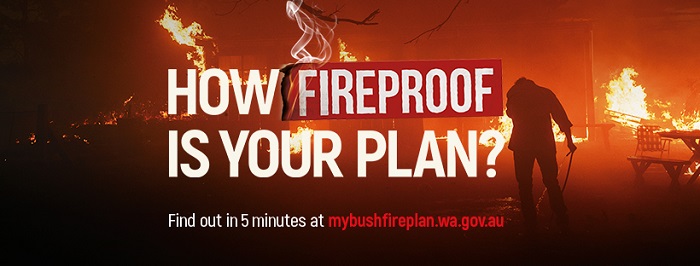Don’t risk your life relying on scheme water during a bushfire

- An independent water supply and pumping capability is vital when planning to stay and defend during a bushfire
- Power outage or damaged infrastructure can result in loss of scheme water
- Above normal bushfire potential predicted for many areas of WA
Water Corporation is reminding Western Australians in bushfire-prone areas not to rely on scheme water if staying to defend their property during a bushfire.
During a bushfire, infrastructure that delivers scheme water to properties can be damaged and power failures can result in a total loss of water.
High demand can also lead to a drop in water pressure and water supply tanks can quickly empty.
Water Corporation Operations Manager Barry Ford said while leaving high-risk bushfire areas was the safest option, those planning to defend their home must have an independent water supply and pumping capability in the event of power loss.
“Our water supply network is designed to provide drinking water to the community, not fight bushfires, and assuming water will always be available during a bushfire could have life-threatening consequences,” Mr Ford said.
“Bushfires can send embers several kilometres ahead, which can knock out the power and water supply before the main fire.
“If you choose to stay and defend your home it’s crucial you have an independent water supply, ideally at least 20,000 litres, and pumping capability, as scheme water supply and pressure cannot be relied upon during a bushfire.
“The recent fire in the Mid West is a timely reminder of the need to be prepared as we head into bushfire season.”
According to Bushfire Seasonal Outlook for Summer 2022* a higher-than-normal fire risk is forecast for central western and southern areas of the state this summer. In the South West, below average rainfall during winter has resulted in low soil moisture, further increasing bushfire risk.
As part of its bushfire preparedness program, Water Corporation undertakes activities throughout the year to reduce risk to critical infrastructure.
This includes clearing land and access tracks within and around pumping stations, storage areas and catchments, and having generators and emergency water carters on standby. During a bushfire it may not be safe for crews to manage or repair damage to the network.
For more information about how a bushfire can impact water supply, visit watercorporation.com.au/Help-and-advice/Water-issues/Natural-disasters-and-incidents/Bushfires-and-your-water-supply
The Department of Fire and Emergency Services’ My Bushfire Plan can help you prepare by creating a personal bushfire survival plan. Visit the My Bushfire Plan website and mobile app at https://mybushfireplan.wa.gov.au for more information.
To support bushfire plans, landowners or occupiers with safe access to bores, rivers, streams or creeks can take and store emergency water without it counting against their entitlements. For more information visit the Department of Water and Environmental Regulation's website at http://www.water.wa.gov.au/fireplanning
*Source: Bushfire Seasonal Outlook for Summer 2022 produced by the Australasian Fire and Emergency Service Authorities Council (AFAC), the national council for fire and emergency services in Australia and New Zealand.